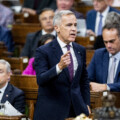On Thursday, June 22, 2023, The Hub’s editor at large, Sean Speer, delivered remarks at an event hosted by the Runnymede Society’s Edmonton lawyers’ chapter. His remarks (published below) set out a brief history of the federal spending power, its rising prevalence under the Trudeau government and the consequences for federal and provincial public policy, and options to ultimately constrain it.
Introduction
Thank you to tonight’s organizers and the Runnymede Society more generally. I’ve written that the Runnymede Society is the most interesting institutional development in the world of Canadian ideas, policy, and politics in some time. That so many of you are here on a warm June night in Edmonton validates my point.
I suspect many here are as disappointed as I am with Russell Brown’s resignation from the Supreme Court. But it seems to me that the Runnymede Society’s growing ambition and energy is fundamental to how we’ll ultimately make progress on the ideas and principles that he came to personify on the bench. As I recently wrote at The Hub: “We need more Russell Browns.” I suspect that there may be some of you in the room tonight.
My family and I are glad to be in Edmonton. We have a lot of great friends in the city. But regrettably we haven’t spent a lot of time here. I came once as a 15-year-old for a hockey tournament. We stayed with billets in St. Albert and the most memorable part of my trip was a visit to the hospital for a broken arm.
I’m going to take the next twenty minutes or so to talk about the Alberta election and its implications for Canadian federalism. Hopefully, it’s not as painful as a broken limb.
The real federalism challenge: Consensus rather than conflict
Now is probably a good time to set out my thesis. My somewhat contrarian take is as follows:
- I think we have a major federalism challenge in our country but I’m not sure that the Alberta election will have a meaningful effect on it.
- That’s because the challenge as I’ve come to think about it is a bit different than how it’s typically understood.
- The common narrative—particularly in Alberta—is about federal-provincial discord. It’s about the Alberta Sovereignty Act. It’s about Western alienation. It’s even about the rise of Albertan separatism.
- Those things are real enough and worthy of our attention and focus. If you value political stability and social cohesion, such developments ought to concern you.
- But I think they conceal something more notable and interesting.
- I think the real story of Canadian federalism these days isn’t about conflict. It’s about consensus. There’s a consensus that stretches from the Liberal government in Ottawa to the conservative governments across the provinces in favour of an expansive view of the federal spending power.
- Yes, of course, we’ll see federal-provincial disputes—including perhaps most notably here in Alberta concerning the impending federal plan for an emissions cap on the oil and gas sector—but these disagreements, as significant as they are, obscure the extent to which both orders of government have come to accept an expansive role for Ottawa to use its spending power to dictate provincial action within their own exclusive jurisdictions.
- It’s striking when you think about it: On the one hand, Premier Smith threatens to use the Alberta Sovereignty Act to block federal action in clear areas of federal jurisdiction, including, for instance, firearm regulation. On the other hand, however, her government’s controversial law is apparently impotent to prevent Ottawa from spending its conditional dollars on provincial health care or child care.
My counterintuitive argument, therefore, is that we have both too much conflict and too little conflict when it comes to federalism and the division of powers.
We fight too much about federal action that, for better or worse, is firmly within Ottawa’s jurisdiction and too little about federal action that is not.
The consequences of distraction federalism
There are various consequences to this form of what I’ve come to think of as a “distraction federalism.”
The first is it conflicts with a conception of the division of powers and the autonomous role of provinces within their jurisdiction. As former Justice Brown wrote in the greenhouse gas reference case: “Within their areas of legislative authority, provinces are not only sovereign, but exclusively so.” Ceding to federal intrusion via the spending power undermines this basic principle.
Yet make no mistake: that’s what the provinces are doing. Alberta is a good (or bad) example. The provincial government was quick to sign health-care and child-care deals with the federal government in the past several months—even though Ottawa’s role in these two areas has little or no constitutional basis. Money trumped constitutional principle.
Danielle Smith rightly described the latter arrangement as “giving total control to Ottawa over how we deliver child care” in a newspaper op-ed before she was premier.
Yet during the recent provincial campaign she boasted about her party’s $10-per-day child care program. It took little more than two years for her to go from a principled critic of federal intrusion into provincial jurisdiction to effectively outsourcing her government’s child-care policy to Justin Trudeau.
The second major problem with “distraction federalism” has played out in Ottawa over the past several months. It’s become readily apparent that the Trudeau government doesn’t have an affirmative view of the role of the national state. It would much rather run provincial or local policy.
The Chinese interference scandal has shown the government has systemically neglected Section 91 responsibilities with respect to national security, intelligence, and defence.
The federal bureaucracy has seemingly had a hard time getting members of the political arm of the government to concern themselves with these issues. Instead, the prime minister, the cabinet, and their unelected advisors seem far more motivated by Section 92 responsibilities.
These distractions—from diminished provincial autonomy in their own jurisdictions to neglectful federal attention on its core responsibilities—are in my view the biggest challenge facing Canadian federalism.
The role of the federal spending power
At the root of this challenge is the federal spending power which has increasingly become one of the principal means of policymaking under the Trudeau government.
As a refresher, the spending power refers to the federal government’s use of its tax and spending capacity to direct spending in areas of provincial or local jurisdiction through a combination of transfers to individuals (such as student grants) or cost-shared programs with provinces (such as health care). It effectively enables Ottawa to use the power of the purse to influence policymaking in areas such as health care or child care outside of its constitutional jurisdiction.
One of the earliest official expressions of the spending power is found in a 1969 federal paper that was presented to a first ministers’ meeting. The white paper put it this way:
Constitutionally, the term “spending power” has come to have a specialized meaning in Canada: it means the power of Parliament to make payments to people or institutions or governments for purposes on which Parliament does not necessarily have the power to legislate.
Ottawa’s use of the spending power used to be the subject of some political controversy. The principal pushback was that it acted as a constraint on provincial sovereignty through its imposition of so-called “national standards.”
The recent national child-care program is a good example of these top-down conditions. In exchange for more than $25 billion in federal dollars over the next handful of years, provinces were forced to accept a range of conditions—including, for instance, granular details about the wages of child-care workers.
It will be well known in this room that nowhere in the constitution does it grant Ottawa a say on how much the market ought to value child-care workers in Drayton Valley or Annapolis Valley but the federal spending power effectively does.
It’s difficult to overstate the importance of this constitutional development in which Ottawa uses federal dollars to buy its way into exclusive areas of provincial policymaking.
The expansion of the spending power in the post-World War II era has rightly been described by the leading economist Thomas Courchene as a “de facto redistribution of power under the constitution.” Yet as Andrew Petter, a former dean of the University of Victoria law school, wrote in a 1988 paper, it was achieved “without constitutional amendment and without the blessing of the Supreme Court.”
In an effort to discipline the spending power, both the Meech Lake and Charlottetown Accords proposed a constitutional amendment that would have granted provinces “reasonable compensation” if they opted out of federal-provincial cost-shared programs. But, of course, neither effort was ultimately successful.
Still, we saw meaningful progress on constraining the spending power during the Harper years. The government wasn’t perfect on this front. There were times, including, for instance, its imposition of policy conditions on intergovernmental transfers for skills training and workforce development, where the Harper government succumbed to the political temptations of the federal spending power. But its record was generally positive.
The most notable case was its decision not to renew its predecessor’s health accord with the provinces and instead limit the federal role in the administration and delivery of provincial health care to the provisions of the Canada Health Act.
I suppose critics might argue that the government ought to have gone further and revisited the Act itself. But looking through the Overton window, I think there’s a strong case that the Harper government’s health-care approach was a meaningful step towards the goal of constraining the federal spending power.
The federal spending power under the Trudeau government: The rise of a conditional partnership
The Trudeau government, however, has moved in the opposite direction. Its policy agenda has been marked by a high degree of ambition within provincial and local jurisdictions and it has restored the federal spending power as the chief means to achieve these ends.
A recent study by the Institute for Research on Public Policy, for instance, documents the growing role of the spending power in general and its heavy-handedness in particular.
It’s not just that the Trudeau government has exhibited an oversized interest in provincial and local policymaking. It’s that, as the study’s authors outline, the trend has been for a “more directive and less collaborative” form of federalism in which “partnership seems conditional on a province accepting the federal government’s policy vision.”
The spending power—particularly in a world of high federal spending enabled by deficit financing—has been the linchpin for this model of “more hierarchical intergovernmental arrangements.” It has been effectively deployed by the Trudeau government to induce provincial agreements to federal terms on child care, dental care, health care, housing, workforce development, and so on.
It’s not much hyperbole to argue that as a result, the prime minister has had as much or even greater influence over provincial policymaking over the past several years than virtually any premier across the country.
I’ve already spoken about the consequences of these developments for Canadian federalism. It’s bad enough that they’ve led to a centralization of national policy that’s contrary to the provincial sovereignty envisioned in the constitution. The resulting homogenization of provincial policymaking fails to account for economic and social particularities, differing political preferences, and the benefits of what American historian Daniel Boorstin called “entrepreneurial federalism.”
But the more practical and urgent concern is the lack of interest in and attention to the awesome power granted to the federal government under the constitution. We’re living in a time of geopolitical turmoil and new national security risks as well as growing public demands for Indigenous reconciliation, climate action, and inflation and price stability. It’s a Section 91 moment and yet we have a Section 92 politics.
The Trudeau government knows what it wants the provinces and cities to do but it doesn’t have a clear vision for its own responsibilities. Its distracted form of federal leadership has contributed to an erosion of Ottawa’s state capacity. Neglect has effectively begot decline. Defence procurement is broken, there are massive immigration backlogs, and for awhile we couldn’t get even passports.
One would think such poor outcomes would lead the federal government to refocus its attention on itself, but the prime minister and his cabinet still won’t stick to their knitting. Their heart is with social policy and so much of social policy ultimately resides at the provincial level. At this point, it seems unlikely anything is going to change the government’s predisposition on these issues.
How to constrain the federal spending power
But that doesn’t mean that we shouldn’t concern ourselves with the goal of constraining the federal spending power and putting an end to distraction federalism.
Let me wrap up my remarks by putting forward three ideas toward these ends. My options should be interpreted as somewhat iterative. They build on one another based on a combination of ambition and their ultimate effectiveness.
- Provinces must protect themselves
The first step is for provincial governments to simply stop ceding to the federal spending power. To borrow from Ronald Reagan, protecting provincial sovereignty is kind of like protecting your virtue: you have to learn to say no.
I was struck, for instance, during the recent round of health-care discussions, by how weak the provinces seemed. They demanded that the federal government raise health transfers such that Ottawa’s share of provincial health-care spending goes from 22 percent to 35 percent. The Trudeau government instead countered with a marginal increase to transfer payments and added a bunch of new federal conditions and the provinces essentially caved.
Canadian history is marked by provincial governments that were far more protective of their own sovereignty than anything we see today including from premiers who tend to be characterized in the media as antagonistic to Ottawa.
Premier Smith and her colleagues in other provinces ought to recommit themselves to protecting their legislative authority from federal intrusion. That starts with saying no to new attempts to use the federal spending power.
- Fiscal federalism reform
Another step is to rethink federal transfers to the provinces in a way that enables greater provincial autonomy with their jurisdictions.
One idea put forward by the leading policy thinker Peter Nicholson is to replace the Canada Health Transfer with the federal withdrawal from the GST. It’s an elegant proposal because the CHT and GST almost net out: the former is projected to the federal government about $50 billion this year and the latter is projected to bring in about $51 billion in revenues.
It would presumably require some boost to Equalization to recognize that the GST points differ in value across the provinces. But otherwise it would be, in broad terms, fiscally neutral for both Ottawa and the provinces.
It’s an idea that’s really worthy of consideration. It would effectively download revenue-generating capacity to the provinces in exchange for reducing Ottawa’s influence over health-care policy. It would, in short, better align the collection of tax revenues and government spending.
This particular proposal would probably involve some ongoing role for the Canada Health Act—particularly with respect to portability of public insurance across provinces—but otherwise it represents in substance and instruction a better approach to fiscal federalism.
- Constitutional or policy constraints on the federal spending power
A final step would be to codify in policy or even by way of a constitutional amendment formal constraints on the federal spending power. The former would be easier to implement but act as a softer constraint. The latter would be the opposite. Both would signal a more limited role for the federal government to use conditional dollars to influence provincial policymaking.
The constraint itself could restore the opt-out clause envisioned in the Meech Lake and Charlottetown Accords or could express greater ambition including a prohibition on new conditional transfers and even unwinding current ones altogether.
There would no doubt be competing views based on prudence and practicality about the best approach. But the key would be to go beyond merely relying on the provinces as the main block on the federal spending power and instead place legal constraints on federal action in areas of exclusive provincial authority.
Conclusion
These steps would confront the false consensus in favour of an expansive view of the federal spending power that, notwithstanding the conventional narrative about the current state of federal-provincial relations, I believe to be at the heart of the biggest challenge facing Canadian federalism.
They would strengthen provincial autonomy within their areas of exclusive jurisdiction and encourage greater federal attention on its own constitutional responsibilities.
Thanks once again for the invitation to join you tonight. I look forward to the discussion.
Recommended for You

Like the Blue Jays, Carney’s first budget falls just short

Canada has been cutting red tape for decades. So why is there even more of it?

The UCP empowered Albertans to have their say. Now it may be coming back to bite them

‘This is significant’: Hub Politics on Carney’s disappointing budget being overshadowed by a dramatic floor crossing




